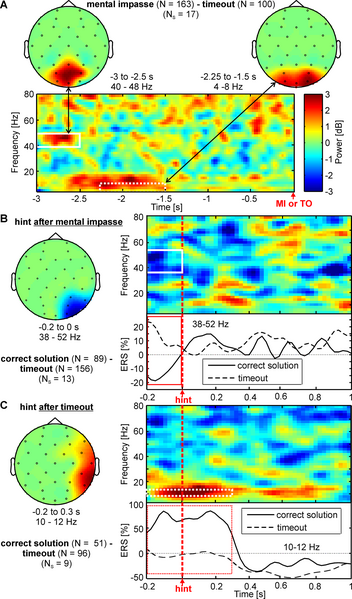Cognitive insight, those flashes of brilliance when a mental breakthrough happens, are widely recognized but very little is known about their constituent cognitive components and underlying neural mechanisms. It is also unclear why trying too hard does more harm than good.
In a study published in PLoS ONE, researchers at Goldsmiths College, London, investigated brain rhythms and their dynamics while human volunteers solved verbal problems.
Often, the participants reached a state of mental block and could not progress further. An excessive amount of gamma brain rhythm (the same rhythm gets enhanced with selective attention) might cause this mental road block, thus reaffirming the belief that focusing too much on a topic is detrimental.
They provided clues to participants in the state of mental block yet they were not always successfully utilized and the researchers discovered it was possible to predict the success or failure based on the brain state prior to the clue presentation. They also found that when the volunteers were consciously aware that they were having a strong breakthrough in their mental strategies, they were less likely to feel the suddenness of "Aha!"

Bhattacharya and colleagues show that a strong "Aha!" sensation involves minimal metacognitive (monitoring of one’s own thoughts) processes and unconscious restructuring or, better, an automatic, subconscious recombination of information which stands in contrast to conscious mental restructuring which is an attention-demanding process involving executive control. The study shows that it is possible to identify these processes before they reach the level of verbal awareness.
Arguably, insight lies at the core of human intelligence, so its proper understanding in terms of a set of underlying neural mechanisms will not only influence the immediate fields of psychology and cognitive neuroscience but also exert sold impact on a range of scientific and educational disciplines. The pedagogical importance is also noteworthy.
For example, a better understanding of complex problem solving behaviour of human subjects will facilitate a better strategy of teaching and enhancing the performance of pupils, formulation of efficient solution strategies which, in turn, enhances the creativity.
Article: Sandkühler S, Bhattacharya J (2008) Deconstructing Insight: EEG Correlates of Insightful Problem Solving. PLoS ONE 3(1): e1459. doi:10.1371/journal.pone.0001459





Comments